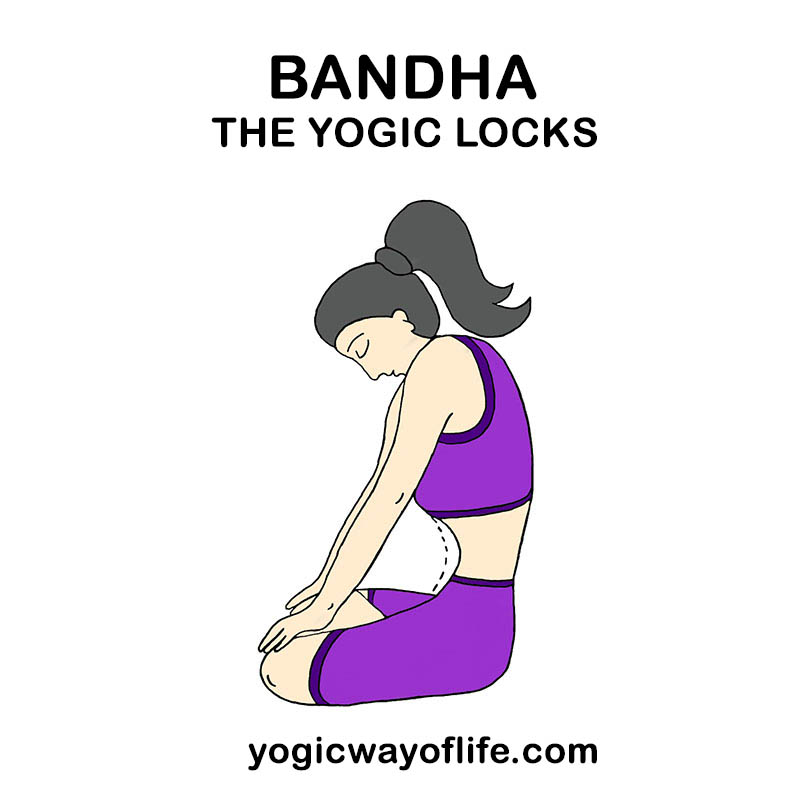Bandha or a yogic lock enables a yogi to block and direct the flow of pranic energy in certain way to change the energy pattern in the body. Bandhas not only modifies the flow of pranic energy through the nadis (energy meridians), but also modifies the flow of nerve currents in the nervous system and blood flow through the blood vessels.
Bandhas are mentioned in most classical yoga texts like Hatha Yoga Pradeepika, Gheranda Samhita, Siva Samhita, etc. In yogic scriptures, the Bandhas are clubbed along with mudras or yogic gestures. The reason for it is that both Bandha and Mudra modifies the energy pattern in the body to give rise to heightened levels of awareness. Hence they can be practised together. Bandhas are practiced before starting the practice of meditation.

Bandhas are usually practiced with retention of breath either inside or outside. Those suffering from Blood pressure problems, heart diseases and ulcers should avoid the practice of Bandhas. Pregnant women too should not do Bandhas.
Bandhas are advanced practices in yoga. They should be learnt under the guidance of an experienced yoga instructor. Usually it is learnt after mastering Asana (yogic postures) and Pranayama (yogic breathing techniques). Practitioners also should take care not to overdo the practice. The yogic locks should be released if you feel any discomfort while holding the breath.
There are four main Bandhas or yogic locks that are practiced. They are Moola Bandha (The Perineum Lock or the Root Lock), Uddiyana Bandha (The Abdominal Lock), Jalandhara Bandha (the Chin Lock) and Maha Bandha (the great lock, which is a combination of all the three locks). A brief description of each lock is given below.
- Moola Bandha or the Root Lock is performed by contracting the perineum muscles for males. For females, the contraction involves the region at the opening of the womb. This can be practiced with either the breath held inside or outside. Moola bandha tones all the organs in the pelvic region and increases control over the sex drive. It can bring out lot of repressed emotions during the practice and hence one needs to watch the thought patterns with a sense of detachment. Constant practice can help to relieve depression. Moola Bandha is said to awaken the Mooladhara chakra below the base of the spine. It also pulls up the Apana vayu (the downward moving energy) and merges it with the Prana vayu. This can release lot of energy and eventually awaken the Kundalini Shakti situated below the base of the spine.
- Uddiyana Bandha or the Abdominal Lock is performed by pulling in the abdomen muscles inwards and also upwards, pushing the abdominal organs against the back side of the spine towards the rib cage. In this lock, the breath is held outside and hence needs a little practice. Uddiyana Bandha massages all the organs in the abdomen. It improves the functioning of the adrenal glands. Generally it is practiced along with Jalandhara Bandha or the chin lock. This enables the Prana and Apana to merge at the solar plexus thereby improving digestive power. Uddiyana Bandha can awaken the Manipuraka Chakra, the energy centre at the navel region. Performing this Bandha, the practitioner is able to move the prana into the Sushuma Nadi, the central pranic channel. This bring about higher levels of awareness and aids in the higher practices of Dhyana and Samadhi.
- Jalandhara Bandha or the Chin Lock is performed by bending the neck forward and pressing it against the chest between the collar bones. This can be practiced with either the breath held inside or outside. This Bandha forces the Prana Vayu to move downwards to meet the Apana vayu. Jalandhara Bandha massages the thyroid and para-thyroid glands and helps to regulate the body metabolism. It activates the Vishuddhi Chakra in the throat region. Yogic texts claim that Jalandhara Bandha can overcome the aging and decay of the body and give victory over death to the yogi.
- Maha Bandha or the Great Lock is done by performing all the three bandhas together. It is practiced by performing the Moola Bandha first, then the Uddiyana Bandha and lastly the Jalandhara Bandha, in that order. The breath is held outside when all the 3 locks are applied. It activates the Ajna chakra or the third eye and regulates all the endocrinal glands. It helps to rejuvenate the cells in the entire body and is a good anti-aging exercise. It can awaken the Prana Shakti and also the sleeping Kundalini Shakti and brings about heightened levels of awareness. Yogic texts call Maha Bandha the conqueror of old age and death.
The practitioner masters the various locks, one at a time. When he is proficient in all the three locks, then the Maha Bandha is practiced.
Bandha or locks hold an important place in the yogic practices. Bandhas along with Mudras (yogic gestures) are essential before taking up the higher practice of meditation and Samadhi.
